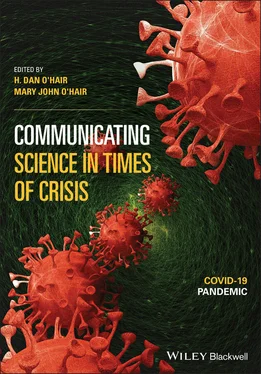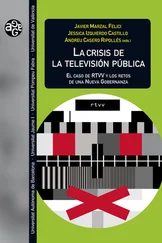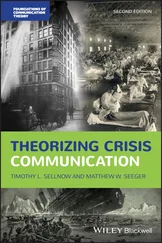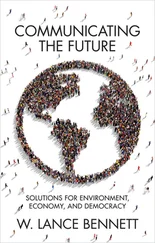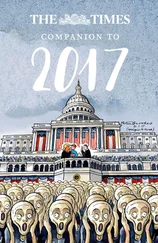3 How Existential Anxiety Shapes Communication in Coping with the Coronavirus Pandemic A Terror Management Theory Perspective
Claude H. Miller and Haijing Ma
University of Oklahoma
Natural disasters, such as earthquakes, tsunamis, hurricanes, tornados, flooding, and draught, happen all too often, as do other man-made crises, such as terrorist attacks, chemical spills, and nuclear meltdowns. In 2020, crises and disasters seem to be the new normal, with monstrous bush fires in Australia; record-shattering forest fires in Western United States; floods in China, Pakistan, and the United Kingdom; and hurricanes and cyclones in the United States, India, Sri Lanka, and Bangladesh.
Topping it all off, the COVID-19 pandemic has wreaked havoc over the entire globe. Since shortly after the first cases were discovered in November 2019 in Hubei province, China, the novel coronavirus outbreak designated COVID-19 has commanded the world’s attention. As the pandemic has unfolded, and fear of its spread has come to dominate the global consciousness, along with its propagation, a wave of aggressive behavior, xenophobia, and protests against preventive measures has developed—particularly within the United States—as many have viewed such measures to be oppressively invasive (Escobar, 2020; Manning-Schaffel, 2020; Stewart, 2020). With over 118 million cases worldwide and more than 2.6 million deaths through the second week of March 2021 (CCSE, 2021), medical authorities and researchers observing the unfolding pandemic have noted increasing anxiety and dread about the virus across a range of international populations, exacerbating a number of serious and broadly experienced mental health issues (Li et al., 2020; Torales et al., 2020), particularly in the United States (Czeisler et al., 2020), where more than 20% of the worldwide deaths have occurred.
Arguably, the threat of death from the disastrous events encompassing the pandemic has left an indelible mark on the world’s collective psyche that has rendered many of the desperate responses wholly understandable, given how fear of death plays such a central role in human experience (Becker, 1973). Knowledge of the finitude of human existence affects countless aspects of our daily lives, powerfully influencing our communication behavior cognitively, affectively, and motivationally, both within and outside of our conscious focal awareness (Miller & Massey, 2020). To manage the resulting existential anxiety, humans cope and adapt in a wide variety of ways (Menzies & Menzies, 2020; Yalom, 2008); for instance, joining groups, finding consensus in a shared cultural worldview (CWV), bolstering and maintaining a sense of self-worth, and developing and nurturing close relationships (Pyszczynski et al., 2015).
However, a realization of the inescapable certainty of our inevitable death can also stimulate feelings of desperation, incomprehensibility, meaninglessness, and fear, motivating a broad range of disruptive and maladaptive behaviors, such as blithely attacking outgroup members perceived as different from one’s self. At the same time, such feelings can also make us more readily willing to tolerate the moral transgressions of ingroup members felt to be similar (Menzies, 2012; Pyszczynski et al., 2015). Among these behaviors, some clearly relate to our mortal fears, while others seem to have no direct link whatsoever. Given the abstracted nature of this existential dilemma, a number of questions arise: In coping with disastrous events such as the COVID-19 pandemic, how might our fear of death and the disquiet and apprehension it engenders influence our communication behavior in ways we may be unaware of? Do thoughts and reminders of death bring only negative consequences? What can we learn from or about the different coping methods individuals use to buffer the anxiety and fear associated with their mortality? Regarding the current coronavirus pandemic, can different aspects of people’s responses to its threat be explained, anticipated, and/or influenced by its death-reminding nature?
From the perspective of terror management theory (TMT; Greenberg et al., 1986), this chapter focuses on how existential anxiety following death thought awareness (DTA) can influence a myriad of communication behavior designed to cope with the fear and dread aroused by the deadly COVID-19 global pandemic. After first briefly introducing the theory, the following sections apply TMT to several aspects relevant to interpersonal, health, and crisis communication. The chapter concludes with a discussion on ways death anxiety may be most effectively managed to help people cope with the COVID-19 pandemic.
In the mid-1980s, unsatisfied with the state of theory explaining several core psychological processes, and curious about the common underpinnings of human motivation, Greenberg et al. (1986) developed TMT as an overarching theory of human motivation. Initially met with a chilly reception, TMT has since provided the explanatory framework for hundreds of empirical studies’ testing and sustaining a broad range of novel hypotheses focusing on “why people behave the way they do” (Pyszczynski et al., 2015, p. 3), and the theory has since enjoyed widespread acceptance—albeit with a healthy measure of criticism.
TMT is based on the writings of several existential philosophers and scholars, and most notably the cultural anthropologist, Ernest Becker and his Pulitzer Prize winning work, The Denial of Death , published in 1973. As a cultural anthropologist, Becker committed himself to integrating and synthesizing an all-encompassing range of insights and ideas across a broad spectrum of disciplines in an ambitious attempt to comprehend the elemental bases of human nature. According to Becker (1973), the process of human evolution and development has essentially culminated in a collection of meaning making systems—he refers to as culture—designed to provide a symbolic defense against our awareness of the inescapable inevitability of death. Becker (1973) took note of a duality in human life: a physical world and a symbolic world through which humans can transcend their corporeal impermanence by concentrating on the symbolic aspects of their existence.
Deeply rooted in Becker (1973)’s thinking, TMT contends that humans are unique in their development of abstract, symbolic thoughts, and the nature of their self-consciousness. And as with all animals, we humans are driven to maintain the viability of our biologically programmed struggle to survive (Greenberg, Solomon et al., 1992; Solomon et al., 1991). However beneficial our extraordinary human cognitive capabilities may be in helping us to reproduce and adapt to challenges from the physical environment, these same abilities have also forced us to realize the inexorability of our physical death (Menzies & Menzies, 2020). As Yalom (2008) notes, we have come to realize our lives “forever shadowed by the knowledge that we will grow, blossom, and inevitably, diminish and die” (p. 1).
Moreover, the realization of the inevitability of certain death conflicts with our biological striving for immortality, generating the overwhelming potential for debilitating existential dread (Greenberg et al., 1986). Fear of death is so biologically instinctive that even clinical professionals who are often exposed to death-related issues within an intellectually cushioned environment—and thus should be somewhat immunized from the terror of death—are nonetheless wholly vulnerable to the paralyzing existential anxiety thoughts death can so powerfully engender (Arndt et al., 2009).
To manage this existential angst, TMT posits that people instinctively engage in two distinct defense mechanisms: proximal defenses, to deal with the conscious awareness of death, and distal defenses, for when thoughts of death retreat from focal awareness, yet remain primed to quicken existential anxiety (Pyszczynski et al., 1999). Proximal defenses are active, conscious, and galvanized when death thoughts are brought into focal attention, as when, for example, the COVID-19 pandemic is being discussed on TV. During such times, efforts are made to contain or push thoughts of death into the distant future. More specifically, proximal defenses work to manage conscious death thought awareness (DTA) by disengaging from the contemplation of one’s mortality so as to remove such thoughts from current concerns (Goldenberg et al., 2000). Furthermore, for this purpose, a variety of communication behaviors are used to achieve the goal of restoring psychological equanimity. For instance, denying one’s susceptibility (“I’m too young to suffer a heart attack”), suppressing death thoughts (e.g., by selectively attending to more optimistic outlooks), or taking specific steps to prevent death (e.g., avoiding contamination, and disinfecting all the surfaces in one’s house) (Menzies & Menzies, 2020; Pyszczynski et al., 1999).
Читать дальше
